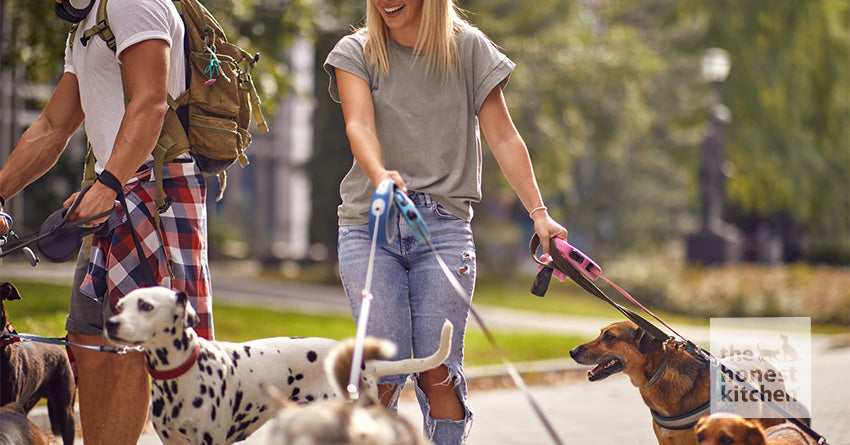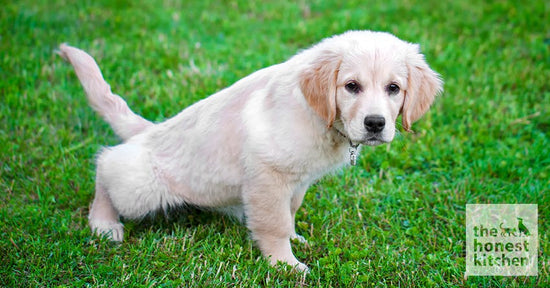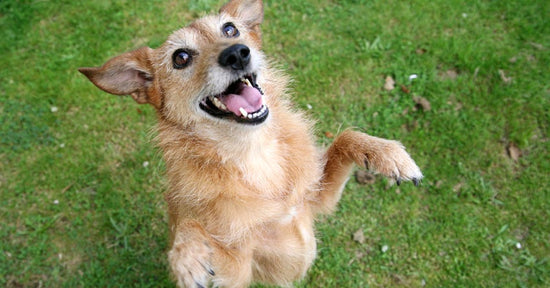A Beginner's Guide to the Best Dog Breeds for First-Time Owners

Over 62 million American households own a dog, making them the most popular pet in the U.S. Dog ownership can be a deeply rewarding experience, but if you’re thinking about becoming a first-time dog owner, there’s a lot to consider.
You’ll need to assess your lifestyle and commitments to determine how a pup can fit in. It’s also important to be intentional about the breed you adopt, as this can have a major impact on your overall experience as a dog parent. We’ll cover this and more below.
What Are Your Needs as a First-Time Dog Owner?
Assessing Your Lifestyle
To determine if your lifestyle is suitable for a dog, evaluate your daily routines, the space you live in, and your activity level. If your daily routine requires being away from home a lot or traveling regularly, consider whether adopting a dog is the best idea for you at this time.
Additionally, consider the space you have. Is it big enough to accommodate a larger dog breed? And finally, are you active enough to keep up with the exercise needs of the breed you’re hoping to adopt? Bringing a high-energy dog into a laid-back family may not be the best fit.
Time and Commitment
Regardless of the breed, you’ll have to adjust your routines to care for them. At the same time, there are levels of time and commitment. A dog that is prone to health issues or requires a lot of attention will demand more of your time than a dog without those special needs.
You might be picturing bringing an Alaskan Malamute into your life, but are you ready to spend time on regular grooming and keeping the highly intelligent breed’s mind occupied ? This is why it’s so important to know yourself as a pet owner so you can match a dog’s needs with your availability.
Family and Household
Last, consider your family and household structure when choosing a dog breed. Do you have children in the house or other pets? If so, choosing a breed that tends to be good with young kids and other animals may be better than bringing home a dog who prefers lone wolf status.
Compatibility with the entire household is key when adopting a dog. This can hopefully lessen the chance of stress on both yourself and your new dog.
The Best Dog Breeds for First-Time Pet Owners
Now, let’s dive into some of the best dog breeds for first-time pet owners, so you can determine which breed is right for your lifestyle.
Labrador Retriever
Labrador Retrievers have historically been working dogs, which helped shape their temperament. The breed became the most popular dog in America during the 1990s due to their friendliness, intelligence, and moderate care needs. These characteristics also make Labrador Retrievers a good fit for first-time dog parents.
Weight range: 55-80 pounds
Height range: 21.5-24.5 inches at the shoulders
Coat type: Short, dense coat of black, brown (chocolate), or yellow
Energy levels: High energy, requiring plenty of exercise
Life expectancy: 10-12 years
Fun fact: Did you know Labrador Retrievers have a thicker-than-typical tail that is sometimes called an “otter tail”? This is because of the shape of the dog’s tail and the way they use it — predominantly as a flipper when swimming.
Golden Retriever
Another sporting breed with a history as a hunting companion and water retriever, Golden Retrievers also make great first-time dogs. They’re known for their gentle temperaments, trainability, loyalty, and eager-to-please attitudes. These traits also make Golden Retrievers great for families with young children.
Weight range: 55-75 pounds
Height range: 21.5-24 inches at the shoulders
Coat type: Thick, golden-brown coat, long on the neck, thighs, tail, and back of the legs
Energy levels: Energetic when appropriate for play or training but can calm down when it’s time to rest
Life expectancy: 10-12 years
Fun fact: Golden Retrievers instinctively love to swim, so if you live near a body of water, this breed may be a great fit. They will likely never turn down a game of fetch in the lake.
Beagle
A small hound dog, popular with both hunters and families alike, Beagles are friendly and curious by nature. They get along easily with other dogs and humans — ideal for first-time dog owners. However, Beagles are also independent and distractible, which can lead to difficulties in training and frustrated pet parents.
Weight range: 20-30 pounds
Height range: 13-15 inches at the shoulders (some can be shorter)
Coat type: Short coat that’s usually a combination of black, white, and tan
Energy levels: They are quite active outdoors but can be calm in the house. However, without mental stimulation, they can become destructive.
Life expectancy: 10-15 years
Fun fact: Beagles are one of the most recognizable dogs in modern times, thanks to Charles Schulz's 1950 creation of the cartoon character Snoopy.
Boxer
Boxers are working dogs that are known for their playful personalities, protective natures, and high energy levels. Historically, this has made them great for police work, but they’re also good watchdogs and companions, making them a popular choice for first-time dog owners. They are also extremely trainable — ideal for service dogs.
Weight range: 65-80 pounds
Height range: 21-25 inches at the shoulders
Coat type: Shiny, short coat of fawn (reddish-brown) or brindle, often with a black mask on their face
Energy levels: High energy, requiring a lot of physical and mental exercise
Life expectancy: 10-12 years
Fun fact: Boxers increased in popularity following World War II, when soldiers brought the dogs home with them and integrated them into their families.
Cavalier King Charles Spaniel
Cavalier King Charles Spaniels are a toy breed originating from English Toy Spaniels in the early 1900s. This breed is adaptable, with a friendly demeanor and low exercise requirements. Cavalier King Charles Spaniels are also great for first-time pet parents and families with children, as the breed is sweet, gentle, and loving — the perfect house dog.
Weight range: 13-18 pounds
Height range: 12-13 inches at the shoulders
Coat type: Medium-length, silky coat with a slight wave and long feathering on the feet
Energy levels: Moderate energy level, somewhat laidback and low maintenance
Life expectancy: 12-15 years
Fun fact: Cavalier King Charles Spaniels have a royal history, and the breed’s name came from King Charles II of Great Britain. King Charles loved his Spaniels so much that he traveled everywhere with them.
Boston Terrier
As their name implies, Boston Terriers are a dog breed developed in the late 19th century in Boston, bred from English Bulldogs and English Terriers.
Boston Terriers often have a friendly and easygoing personality, making them a great option for new dog owners. They’re also self-assured, lively, playful, and sometimes mischievous, which makes for an entertaining new best friend.
Weight range: 12-25 pounds
Height range: 15-17 inches at the shoulders
Coat type: Short, fine coat that’s black or brindle, often with white on the face, chest, neck, and legs.
Energy levels: High energy requiring daily exercise, but also content to cuddle in their owner’s lap
Life expectancy: 11-13 years
Fun fact: The most well-known Boston Terrier mix was Sergeant Stubby, a dog who served in World War I. Sergeant Stubby boosted morale but also warned soldiers of gas attacks and incoming missiles, thanks to his ability to hear the whistle of the shells sooner than the troops.
Bichon Frise
A modification of the French term bichon à poil frisé, “curly-haired lap dog,” Bichon Frises are a small dog breed with fluffy coats, cheerful attitudes, and minimal shedding.
Bichon Frises are typically a friend to everyone, which makes them a solid choice for families with young children, as well as new dog owners. They also tend to get along with other household pets.
Weight range: 12-18 pounds
Height range: 9.5-11.5 inches at the shoulders
Coat type: Puffy, silky, curly coat, with an undercoat that is mostly pure white
Energy levels: Moderate energy, requiring daily walks and vigorous indoor games
Life expectancy: 14-15 years
Fun fact: Another breed with a royal background, Bichon Frises were beloved by French and Spanish royalty, as well as artists like Francisco Goya. They reportedly inspired the French verb bichonner, “to pamper.”
Poodle
Though Poodles originated in Germany, they are widely associated with France, where they are extremely popular. Poodles are best known for their intelligence and hypoallergenic coat, which make them great family dogs for households with dog allergies. Because of poodles’ intelligence, they are also very easy to train and make good service dogs.
Weight range: 7-70 pounds, depending on the type
Height range: 10 inches at the shoulders (toy), 10-15 inches (miniature), more than 15 inches (standard)
Coat type: Wiry outer hair with a dense undercoat that requires regular grooming. Even purebred poodles can come in a wide variety of colors.
Energy levels: All three poodle varieties are energetic, but toy and miniature poodles are often more active than standards. They also require mental stimulation more than other breeds.
Life expectancy: 10-18 years
Fun fact: As noted, poodles come from Germany originally, where they served as medieval duck-hunting dogs. The breed’s name comes from the German word “pudelin,” which means “to splash.”
Shih Tzu
If you’re looking for a toy dog breed for your first pet, consider the Shih Tzu, a Tibetan dog breed developed from the Pekingese and Lhasa Apso breeds. The breed is known for adaptability, a bold but friendly attitude, and an affectionate nature toward people and other pets.
Weight range: 9-16 pounds
Height range: 10 inches at the shoulders
Coat type: Dense, curly coat that comes in a variety of colors. They require brushing every day or two, and you’ll need to trim their hair over their eyes to keep it from interfering with their vision.
Energy levels: Fairly high-energy and require regular exercise, but can easily transition from playtime to relaxing on their owner’s lap
Life expectancy: 10-18 years
Fun fact: Shih Tzu’s have a long history dating back more than 1,000 years. They were largely unknown outside of Tibet until the 1930s and didn’t become recognized by the American Kennel Club until 1969.
Brittany
The Brittany, previously known as the Brittany Spaniel, is a sporting dog breed that is enthusiastic, energetic, intelligent, and eager to please. These attributes make Brittanys easier to train, and they fit into active family dynamics well. Historically, Brittanys helped hunters find and retrieve game.
Weight range: 30-40 pounds
Height range : 17.5-20.5 inches at the shoulders
Coat type: Flat coat with a little feathering on their ears, underside, and legs. They can have a variety of colors, including white, black, orange, and tricolor.
Energy levels: High energy, requiring at least one hour of vigorous exercise each day and long walks
Life expectancy: 12-14 years
Fun fact: Even though Brittanys were bred as sport dogs who love helping hunters, they can be sensitive and gentle. They require positive training from loving owners who don’t leave them at home alone for too long.
Papillon
Another toy breed to consider is the Papillon, a breed known for its intelligence, trainable nature, and small size yet big personality. Thanks to their high intelligence levels, they require a lot of mental engagement.
Their smart nature also makes them eager to join family fun and compete in agility sports — or, for less ambitious dog owners, simply do tricks for the kids.
Weight range: Up to 11 pounds
Height range: 8-11 inches or less inches at the shoulders
Coat type: Long, soft, full coat, usually white with patches of black, tan or dark reddish-brown
Energy levels: Moderate energy levels — they love to play, but their small size means they get worn out quickly.
Life expectancy: 13-15 years
Fun fact: Papillons served as companion dogs for notable figures in the 16th century, including Madame de Pompadour and Marie Antoinette.
Bernese Mountain Dog
If a big, furry dog is what you’re looking for, consider a Bernese Mountain Dog as your first pup. These dogs may be huge, but they are also gentle and friendly. Bernese Mountain Dogs tend to be affectionate, demonstrative, playful, and easy to train. These personality traits make them generally friendly toward strangers and other animals.
Weight range: 70-115 pounds — this large dog breed requires a lot of physical space.
Height range: 23-27.5 inches at the shoulders
Coat type: Long, silky, black coat with rust-colored spots on the chest and forelegs and white on the nose, tail tip, and sometimes feet
Energy levels: Low energy compared to most dogs, but socialization is important to keep their minds occupied.
Life expectancy: 7-10 years
Fun fact: Bernese Mountain Dogs, also affectionately known as “Berners,” respond well to laughter and are believed to have a sense of humor. They will often deliberately repeat acts over and over again that make people laugh.
Find Your Perfect Companion and Choose The Honest Kitchen
Now that you have a sense of some of the best breeds to consider as a first-time dog owner, you can choose the right dog for your lifestyle. You may even feel ready to leap into pet parenthood and bring home your first dog.
As you start on that journey, there’s a lot to keep in mind, including your pup’s overall health. The Honest Kitchen supports new dog owners by providing high-quality, nutritious food tailored to dogs of all breeds and life stages.
Learn more and explore the full collection from The Honest Kitchen.





